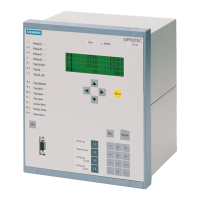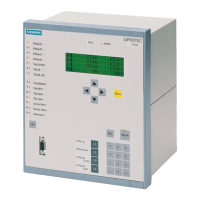Functions
2.50 Command Processing
SIPROTEC, 7UM62, Manual
C53000-G1176-C149-7, Release date 03.2010
358
Blocking by Protection
With this function, switching operations are blocked by the pickup of protective elements. Blocking is config-
urable separately for both closing and tripping commands.
When configured, "Block CLOSE commands" blocks CLOSE commands, whereas "Block TRIP commands"
blocks TRIP signals. Operations in progress will also be aborted by the pickup of a protective element.
Device Status Check (set = actual)
For switching commands it is checked whether a switching device is already in the desired position (compari-
son between desired and actual position). This means that if a circuit breaker is already in the CLOSED position
and an attempt is made to send a closing command, the command will be rejected with the response "sched-
uled condition equals actual condition". Switching devices in the fault position are not interlocked by software
means.
Bypassing Interlocks
Interlockings can be bypassed to perform switching operations. This is either done in-ternally by adding a
bypass code to the command, or globally by so-called switching modes.
• SC=LOCAL
– The switching modes "interlocked" or "non-interlocked" (de-interlocked) can be switched over for the
7UM621 and 7UM62 in the operator control panel after password entry; for the 7UM623 this is done by
means of a keyswitch.
• REMOTE and DIGSI
– Commands issued by SICAM or DIGSI are unlocked via a global switching mode REMOTE. A separate
job order must be sent for the unlocking. The unlocking applies only for one
switching operation and for
commands caused by the same source.
– Job order: command to object "Switching mode REMOTE", ON
– Job order: switching command to "switching device"
• Derived commands from CFC (automatic command, SC=Auto):
– Behaviour configured in the CFC block ("BOOL to command").

